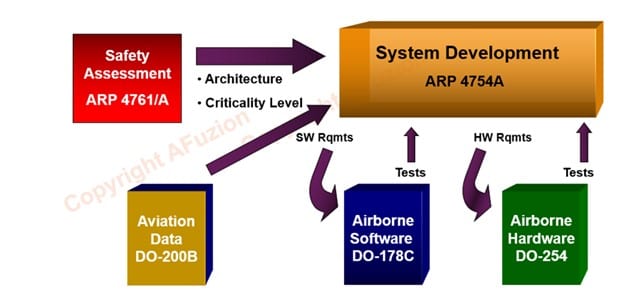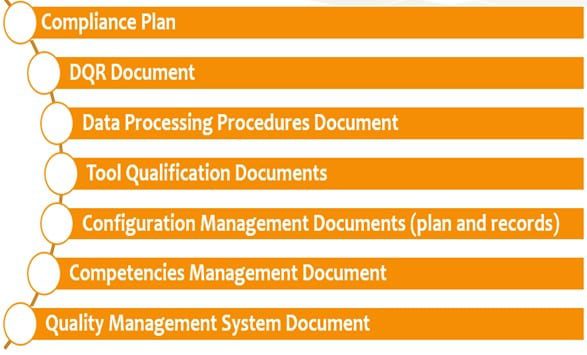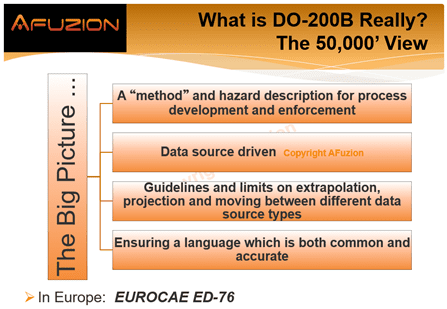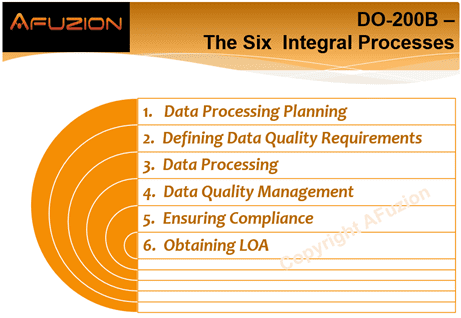DO-200B/C and the related DO-201 are compliance standards for aeronautical data. DO-200B/C has some similarities to DO-178, which is the main guideline for avionics software, but the databases and tools that have to comply with DO-200B/C are complex, multi-sourced, constantly evolving, and necessitate full control over aeronautical data from start to finish.
In other words, DO-200B/C, “Standards for Processing Aeronautical Data,” is a cornerstone within modern aviation. While DO-178 tends to require the most attention as the main standard for airborne software and DO-278 carries high importance as the main standard for ground and satellite-based avionics software, DO-200B/C remains the workhorse upon which modern aviation relies, both directly and indirectly. Why? Because DO-200B/C governs the means by which data necessary for safe aircraft operations is prepared, updated, utilized, and maintained.
DO-200C (called ED-76B in Europe) is the latest update of DO-200B/C Standards for Processing Aeronautical Data. DO-200C has the following key changes over DO-200B/C:
- A new numbering format is now be used for all objectives in DO-200C. Any organization with a compliance matrix based on DO-200B/C objective numbers will need to change all the objective numbers to a new format. Some objectives were consolidated, and some moved. So, the old-to-new mapping is not one-to-one. However, there is a new DO-200C Appendix G that provides this mapping.
- DO-200C has a new DPAL was added. The DPALs are now: 1, 2, 2B, 3. There is no 2A. “B” stands for “basic”.
- All the “shalls” were removed from Section 3 (Compliance) in DO-200C
- The validation guidelines (i.e., extent of validation as a function of DPAL) in appendix C of DO-200C are more flexible than under DO-200B/C.
- There is an entirely new DO-200C Appendix D.3 related to tool qualification called “Additional Adaptations for Tool External Components”. This appendix has a set of objective adaptation tables intended to clarify how tool external components are to be handled under DO-200C with approximately 33 primary Objectives.
Consider the following statements and assess whether they are true or false; answers and explanations are provided within this paper:
- T / F: DO-200B/C applies to Terrain Data, Navigation Data, and Engine Data.
- T / F: The three basic DO-200B/C processes are Data Quality Requirements, Data Processing Requirements, and Quality Management.
- T / F: The Supplier is primarily responsible for ensuring data usage integrity.
- T / F: : A Type 1 Letter of Acceptance requires testing on the specified avionics end-item.
- T / F: All Data Processing tools need to be qualified for Level 1 data.
If the above questions were truly easy, congratulate yourself on your genuine expertise. If they weren’t so easy to answer, then the information that follows is for you.
Contents:
- Basics of DO-200B/C Compliance
- Minimum Standards
- Recommended Standards
- DO-200B/C, DO-200B, ARP4754A, and DO-178C
Basics of DO-200B/C Compliance
To summarize, DO-200B/C provides guidance for the following aspects of aeronautical data:
- Minimum standards and guidance for processing aeronautical data
- Specific definitions for Aeronautical Data, for example, data used for navigation, flight planning, terrain awareness, flight simulators, etc.
- Criteria for developing, changing, and supporting aeronautical data
- Methods to ultimately provide assurance of high data quality
- Criteria for assessing and “qualifying” tools used in the aeronautical data chain which automate, augment, or replace data activities previously performed manually
Table of Contents
However, such aeronautical data doesn’t just sit around in aircraft, ground, or space-based systems. It inevitably must be stored, processed, and updated externally. As a result, the data and the systems that produce and manage it must be protected.
Minimum Standards
DO-200B/C Versus DO-200A: the changes between DO-200A and DO-200B/C are not large. DO-200B/C is a modest upgrade to an earlier version of the standard DO-200A. Whereas 200A focused more on navigation data, DO-200B/C focuses more on aeronautical data. DO-200B/C also addresses data security, mandatory QMS, more rigor for tool qualification for software covered by DO-330, clarification of documents to comply with DO-200B, and expanded definitions/clarity.
DO-200B/C provides the “minimum” standards for maintaining data quality and security. The user is encouraged to, and often must, do more than the “minimum” guidance provided within DO-200B/C. After all, aeronautical data can take on so many different forms, and the future of aviation will assuredly include data in categories currently unknown or underutilized, such as data produced and collected through completely autonomous systems. So it stands to reason that DO-200B/C cannot possibly include sufficient details for each data source or format.
A similar situation exists for software and hardware via DO-178 and DO-254. Although those standards apply to virtually all airborne avionics systems, from bathroom lights to thrust reversers to navigation systems, the added requirements for each system type are not addressed within the standards. Each type has its own more complex requirements beyond what DO-178 or DO-254 can completely address.
Fortunately, other required certification documents such as Technical Standard Orders (TSO’s) supplement DO-178 and DO254 by laying out additional system-specific requirements for typical hardware and software systems. By contrast, aeronautical data requirements specific to each system or tool are rarely addressed within the documents that support DO-200B/C.
One notable exception is the Advisory Circular (AC) 20-153A, “Acceptance of Aeronautical Data Processes and Associated Databases,” which is a must-read for all DO-200B/C practitioners. Since DO-200B/C largely stands on its own, it is particularly imperative for users of DO-200B/C to remember that the minimum standards are almost certainly insufficient for most projects. That means it’s up to the user to develop additional standards specific to particular data and processes to ensure the highest level of data integrity and safety.
Recommended Standards
To help users know what other standards might help maintain data integrity in these diverse systems, DO-200B/C also provides “recommended standards” as opposed to strict requirements. To understand how those recommendations were developed, it’s important to understand where DO-200B/C came from. The document was developed by more than 245 people from around the world, principally from aviation product development companies, but also inclusive of key certification authorities and military personnel. As with nearly all committees, DO-200B/C’s authors had to reconcile conflicting interests with an all-too-common desire to develop the impossibly perfect document that could be “all things to all people.” As a result, DO-200B/C’s 77 pages apply to both large and small aeronautical data sets, different criticality levels, and different users.
The prevailing concern from the start was that “provable quality systems” should outweigh “strict process steps” where aeronautical data is concerned. In other words, the exact way the user maintains data quality is less important than the act of proving and ensuring high-quality data. Each user must carefully consider and then analyze their contribution to safety by asking the following questions for each step within their data chain, meaning the process through which data is created, maintained, stored, or managed:
- “Could their data usage methods or tools fail to detect an error?”
- “Could their data usage methods insert an error?”
- “Could their data usage propagate an error based on an incorrect input?”
- “What are answers to the above questions considering the data development and usage ecosystem and tool-chain?”
DO-200B/C, ARP4754A and DO-178C
The relationship of DO-200B/C to ARP4754A and DO–178C is depicted in the following figure, “DO-200B/C Ecosystem for Aeronautical Data Certification”:

Expand
The top four purposes of DO-200B/C are summarized in the following DO-200B/C Purposes Figure:

Figure: DO-200B/C Purposes
DO-200B/C requires planning, data requirements, processing requirements and proof of related processes; these items must then be validated and verified throughout the data-chain, beginning with data receipt and ending with data transmission. (Note that AFuzion’s DO-200B/C training is provided to governments and private aero data companies in more than 20 countries, including Australia, New Zealand, Iceland, Spain, Turkey, Israel, Germany, Italy, USA, and Canada. AFuzion provides private, customizable DO-200B/C training classes. AFuzion also provides DO-200B/C audits, reviews, and mentoring. Contact us to learn more.
In DO-200B/C, there are two main entities involved in ensuring data quality. The first is data suppliers, meaning aeronautical database providers. The second is users, meaning the manufacturing and development companies or any other entity that is making use of the data. Both share responsibility for DO-200B/C compliance. The documents they use to do that for a typical DO-200B/C project are depicted below:

Figure: Required DO-200B/C Documents
The novice DO-200B/C aeronautical data user may easily confuse DO-200B/C with DO-178, since both apply to software. However, as shown in the Figure below, DO-200B/C is quite different from the avionics software guideline DO-178:

The figure below explains what DO-200B/C really is, readily depicting that DO-200B/C is a framework for ensuring aeronautical data integrity through data inception, manipulation, processing, and transmission:

Figure: Summary of DO-200B/C’s Focus
DO-200B/C compliance requires the application of six integral processes, as depicted in the figure below:

Figure: DO-200B/C’s Six Integral Processes for Aeronautical Data:
The preceding material provides a brief overview of DO-200B/C. Advanced DO-200B/C information and techniques are provided in the corresponding one- or two-day workshop titled “Understanding DO-200C” by this author which includes the following topics:
- Understanding DO-200C’s data chain
- Applying DO-200B/C processes, including planning, processing, deployment, and assessment
- Leveraging DO-178 into DO-200C
- CMMI versus DO-200C
- Building QA proficiency for DO-200C
- DO-200C: Best practices
- DO-200C: Top Mistakes and how to avoid them
- DO-200B/C Record Keeping
If you want to learn more about DO-200B/C, download the whitepaper below.

Information Request Form
Please provide the following information to receive your full Whitepaper
Other Free Resources
- Free 30-minute tech telecon to answer any of your tech Q’s
- Free Sample Certification Checklist
- Free AFuzion Training Video Sample
- Request invitations to future AFuzion tech webinars, fee waived (free)



